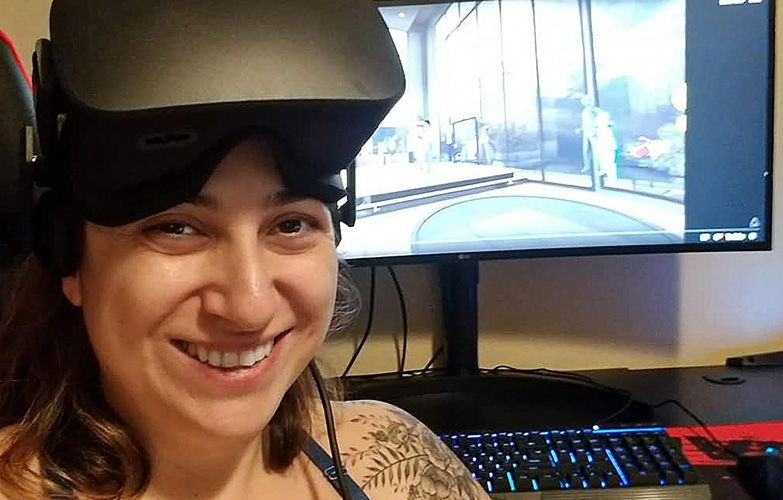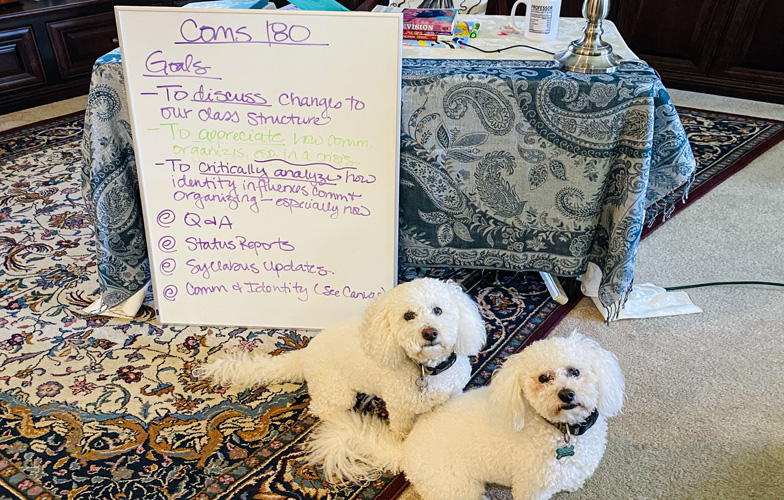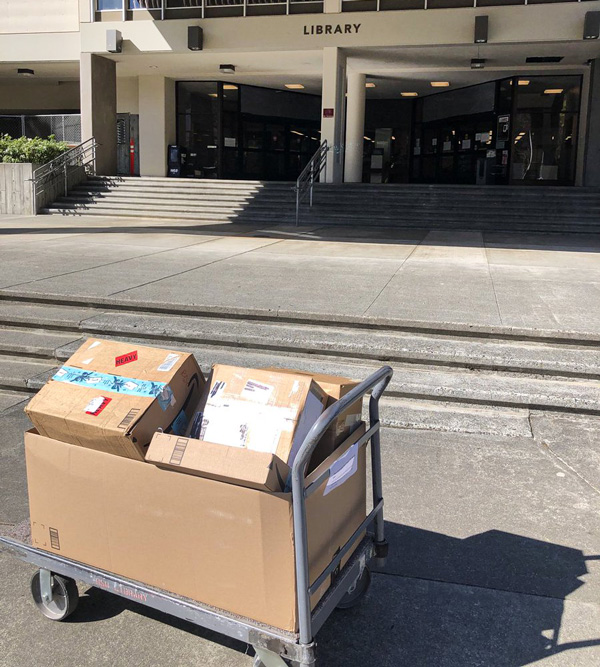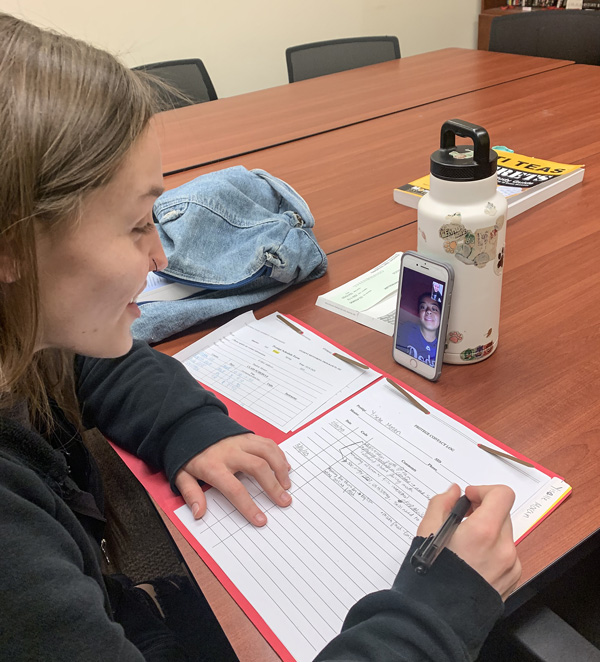
BANDING TOGETHER: HOW THE CSU
REMAINS RESILIENT IN A TIME OF CRISIS
See how the CSU is taking strides to keep teaching and learning on track.
 Tumay Tunur, Ph.D., an assistant professor at CSU San Marcos, dons a virtual reality headset at home to teach a class.
Tumay Tunur, Ph.D., an assistant professor at CSU San Marcos, dons a virtual reality headset at home to teach a class.
 Shawna Malvini Redden, Ph.D., an assistant professor at Sacramento State, set up her home office for virtual instruction. Pictured are Dr. Redden's "office staff," Walter (left) and Clyde (right).
Shawna Malvini Redden, Ph.D., an assistant professor at Sacramento State, set up her home office for virtual instruction. Pictured are Dr. Redden's "office staff," Walter (left) and Clyde (right).
Shawna Malvini Redden, Ph.D., graduate program coordinator and an assistant professor in the Communication Studies Department at
California State University, Sacramento, has rebuilt her courses to maintain a high level of interaction with students. That includes Zoom check-ins, discussion boards and even Twitter chats, with the intent to reduce as much burden as possible.
“I’ve suspended the elements I’m normally a stickler about, such as attendance and late work in order to be as flexible and empathetic as I can,” she explains. “Many of my students have young children or elderly family members they care for. I want them to be able to complete our class successfully while prioritizing their family’s well-being.”
That sentiment should also extend to faculty, says Laura Arce, Ph.D., lecturer of biological science and director of the Research Careers Preparatory program at
California State University, Fullerton. “I moved my furniture around to accommodate a workspace and just went live! I decided I would allow myself not to be perfect," she recalls. "Being good but not perfect is hard for an A-type personality, which most faculty are, but we care and have lots of knowledge to give our students.”
SHARING OUR RESOURCES
As courses transition online, making sure essential hardware and resources are available is a priority. “Instructional & Information Technology Services at our San Marcos campus has been quick to create online resources and allow faculty, staff and students to check out equipment such as laptops, monitors or tablets,” Dr. Tunur says.
Staff members at
California State University, Bakersfield stood out in the rain to hand out Chromebooks—while maintaining safe social distancing.
San Francisco State University announced 200 devices available for loan, and
Humboldt State University shipped out computers to students who needed them.
 Humboldt State shipped out computers to students who did not have access to them at home.
Humboldt State shipped out computers to students who did not have access to them at home.
California State Polytechnic University, Pomona
is offering access to free e-books through its
Bronco Bookstore, and the
CSU Entertainment Alliance
has provided students with a free, year-long subscription to MasterClass, which offers courses taught by industry professionals.
“I just picked up…a Wi-Fi hotspot, an iPad and a bag full of food from campus,”
California State University, Fresno student Jade Munoz recently tweeted. “I want to thank Fresno State for the services provided during these times.”
HELPING THOSE IN NEED
The fallout from COVID-19 can lead to feelings of isolation, anxiety about health and finances and uncertainty about the future. Following the announcement that many spring commencements have been postponed, graduating students are dealing with a special kind of disappointment. “We’ve all been looking forward to being able to walk across that stage and have our moment to shine,” laments Brianna Carrillo, a fourth-year student at
California State University, Northridge majoring in kinesiology.
Scott Newhouse, an adjunct professor of finance and financial planning at CSUN, says he’s received resources regarding how to encourage students during the current pandemic. “Some of them are going through tough times with their families because of the financial hardship this is causing. But they’re still somehow dedicated enough to put in the work to finish classes and get their degrees. It means a lot to be part of a school that cares so deeply for the well-being of its students.”
Food pantries on several campuses remain open to assist students in need, and Fresno State is providing free breakfast and lunch for essential staff and faculty whose skills and services are still needed on campus.
“Food is an essential service in these challenging times, and it provides a sense of normalcy,” says Genie Kim, director of wellbeing at Cal Poly San Luis Obispo. “One of the things we’re really committed to is ensuring all our community, including staff and faculty, have access. We have many students who may be losing income because they're not allowed to do their jobs remotely, so we know this service is really important to our community.”
In addition to the food pantry, Cal Poly San Luis Obispo’s Campus Health and Wellbeing is still offering medical services, counseling services, proactive health education promotion services and crisis advocacy for sexual assault and gender-based violence.
KEEPing IN CONTACT
To keep a
sense of community, Dr. Malvini Redden says her class is “sharing funny memes and pet pictures, as well as links to various resources for financial assistance and jobs, at-home exercise programs and health information.”
Fallon Riggs, a third-year nursing student and mentor at
California State University, San Bernardino, found an innovative way to keep in touch with her mentee. Instead of canceling their session, the duo took to FaceTime and continued on as planned.
 Cal State San Bernardino student-mentor Fallon Riggs (left) meets with her mentee via FaceTime.
Cal State San Bernardino student-mentor Fallon Riggs (left) meets with her mentee via FaceTime.
“It’s more important than ever to receive and provide mentoring during this time,” she says. “Virtual learning for students who may have never done it before can be scary. They may also not realize they have access to resources that can help them have a better experience. This is a time that is uncertain and uneasy for a lot of us, and it’s important for mentors and mentees to keep the connection and trust we have built throughout the whole year.
“The most important thing I remember is this is temporary,” she continues. “I love how everyone is coming together to make virtual learning work to our advantage. It’s definitely different, but we can and will make it work.”
See more
examples of how the CSU is sharing resources; find out information on how the CSU has responded to the
COVID-19 pandemic. Use the hashtag #CSUforCA to see how we are helping California rebound.
Story: MICHELLE MCCARTHY
photoGRAPHY: C/O CSU CAMPUSES
Share this story